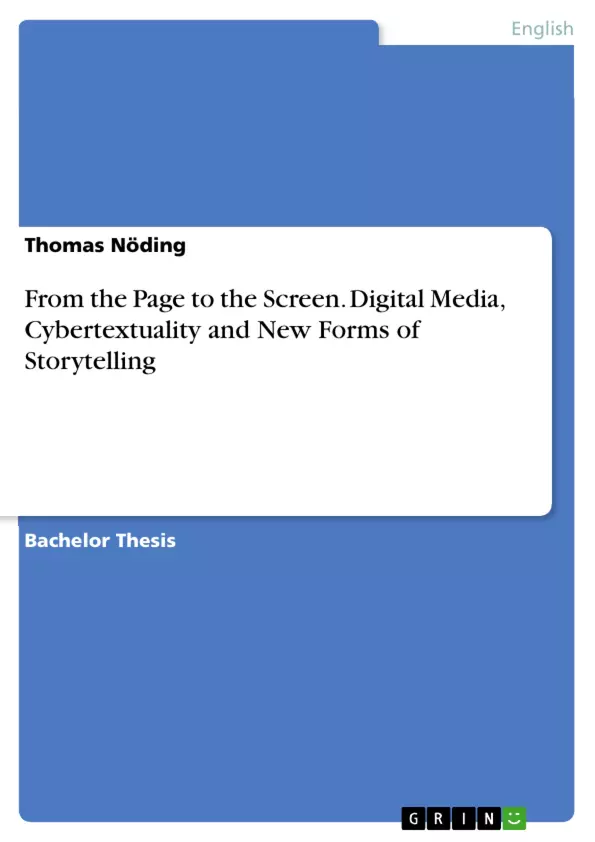This paper is dealing with the developments of digital media and technology over the past three decades, and provide an insight in how they have influenced and changed the overall understanding of textuality and literature. New forms of text and narrative have evolved along the way with new technologies, which have also opened new perspectives on the way in which text is produced and stories are told.
Just as the invention of the printing press has set mankind into a new era of knowledge and literacy more than 500 years ago, the digital media offer the opportunity to experience and observe a similar significant stage in the evolution of text in real-time. How these new forms of text will influence the former ones, and where the further developments will lead, is not an easy question to answer. However, stories will always want to be told and they will find their way out into the world, just like water is making its way through solid rocks by using the smallest cracks.
Computers have taken over the world. Even if this sounds like a phrase which could easily be taken from a Hollywood movie, it is definitely true that computers and other digital technologies are more and more penetrating the daily life of people around the world. An increasing amount of time is spent on the computer, which we can now conveniently carry around in our pockets, providing us with the opportunity to access seemingly unlimited knowledge and information regardless from where we are. Technologies such as smartphones and social networks have influenced the way we think, how we interact with our environment, and also how we are consuming and interpreting text.
Inhaltsverzeichnis (Table of Contents)
- 1.0 Introduction
- 2.0 Socio-historical perspectives on the interrelation of language, technology and literature
- 3.0 Conceptualization of digital literature and cybertext
- 3.1 Virtuality, interactivity and the reader-user convergence
- 3.2 Narrative in digital text
- 4.0 The early stage of electronic literature: Hypertext
- 5.0 Storyspace Hyperfiction: Michael Joyce's Afternoon, a story
- 6.0 The Fusion of reading, writing, and playing: text-based computer games and the multi-user dungeon
- 7.0 Aardwolf: A contemporary MUD
- 8.0 The mobile internet revolution and transmedia narrative
- 9.0 Murder in Passing
Zielsetzung und Themenschwerpunkte (Objectives and Key Themes)
This bachelor thesis examines the evolution of digital media and its impact on the understanding of textuality and literature over the past three decades. It explores how new forms of text and narrative have emerged with the development of new technologies and the consequences these new forms have on the production and storytelling processes.
- The relationship between language, technology, and literature
- The development of digital literature and cybertext
- The impact of interactivity and reader-user convergence on narrative
- The evolution of electronic literature, from hypertext to transmedia narratives
- The future of digital text and electronic literature
Zusammenfassung der Kapitel (Chapter Summaries)
- Chapter 1.0 Introduction: This introductory chapter provides a general overview of the thesis's scope and its focus on the impact of digital media on textuality and literature. It emphasizes the significance of the digital revolution and its influence on the way we consume and interpret text.
- Chapter 2.0 Socio-historical perspectives on the interrelation of language, technology and literature: This chapter explores the historical evolution of the relationship between language, technology, and literature, highlighting the influence of various technological innovations on literary forms and communication.
- Chapter 3.0 Conceptualization of digital literature and cybertext: This chapter introduces key concepts and definitions related to digital literature and cybertext, examining the role of virtuality, interactivity, and the convergence of the reader and user in shaping new literary experiences.
- Chapter 4.0 The early stage of electronic literature: Hypertext: This chapter delves into the early development of electronic literature, focusing on the hypertext genre and its influence on the concept of narrative structure and reader engagement.
- Chapter 5.0 Storyspace Hyperfiction: Michael Joyce's Afternoon, a story: This chapter analyzes a specific example of hyperfiction, Michael Joyce's "Afternoon, a story," showcasing its unique narrative structure and the possibilities for reader interaction within a hypertext environment.
- Chapter 6.0 The Fusion of reading, writing, and playing: text-based computer games and the multi-user dungeon: This chapter examines the intersection of literature and gaming, focusing on text-based computer games and the multi-user dungeon (MUD) genre. It explores the ways in which these platforms blur the lines between reading, writing, and participation.
- Chapter 7.0 Aardwolf: A contemporary MUD: This chapter explores the evolution of MUDs, analyzing a contemporary example, "Aardwolf," to demonstrate the continued relevance of this genre and its potential for narrative engagement and social interaction.
- Chapter 8.0 The mobile internet revolution and transmedia narrative: This chapter explores the impact of the mobile internet revolution on narrative forms, focusing on the rise of transmedia storytelling and its implications for traditional literary concepts.
- Chapter 9.0 Murder in Passing: This chapter analyzes a specific example of transmedia narrative, "Murder in Passing," to showcase its multi-platform storytelling approach and its potential for immersive and interactive experiences.
Schlüsselwörter (Keywords)
This bachelor thesis focuses on the intersection of digital media, textuality, and literature. Key terms and concepts explored include digital literature, cybertext, hypertext, transmedia narrative, interactivity, reader-user convergence, narrative structure, and the evolution of storytelling in the digital age.
- Arbeit zitieren
- Thomas Nöding (Autor:in), 2014, From the Page to the Screen. Digital Media, Cybertextuality and New Forms of Storytelling, München, GRIN Verlag, https://www.grin.com/document/519992



